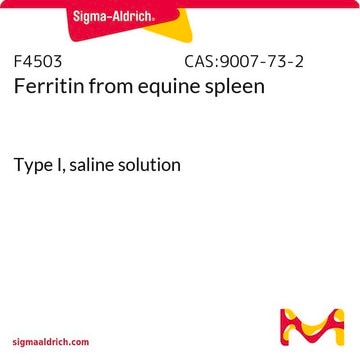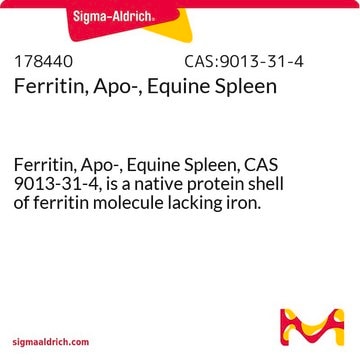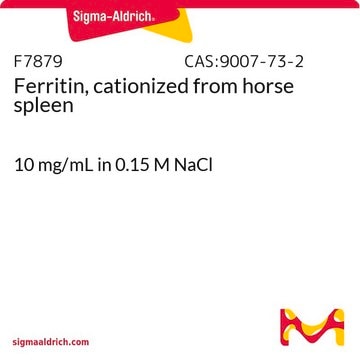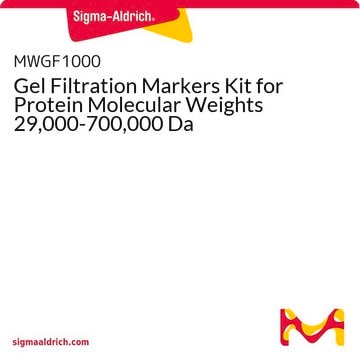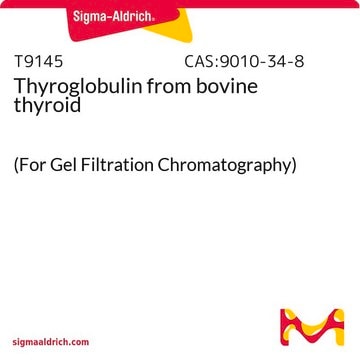Recommended Products
Quality Level
sterility
0.2 μm filtered
form
liquid
mol wt
major subunit ML 19,889
minor subunit MH 22,200
native ~481.2 kDa (24 subunits, approx. 20 kDa each)
color
clear to slightly hazy, solution
storage temp.
2-8°C
Looking for similar products? Visit Product Comparison Guide
Application
Apoferritin from equine spleen has been used:
- to determine its partition coefficients in phase systems
- in NaCl for iron loading of cultured cells
- in in situ liquid scanning transmission electron microscope for imaging the interface of biology and nanotechnology
Biochem/physiol Actions
This protein shell of ferritin lacking iron is widely used for the calibration of gel filtration columns and sodium dodecyl sulfate (SDS)-polyacrylamide gel electrophoresis. It is very abundant in beta-cells of the pancreas where it acts as an anti-oxidant. When added to cultured endothelial cells apoferritin is taken up in a dose-responsive manner and appears to protect the cells from oxidant-mediated cytolysis.
Physical form
Solution in 0.135 M sodium chloride.
Storage Class
10 - Combustible liquids
wgk_germany
WGK 3
flash_point_f
Not applicable
flash_point_c
Not applicable
ppe
Eyeshields, Gloves
Certificates of Analysis (COA)
Search for Certificates of Analysis (COA) by entering the products Lot/Batch Number. Lot and Batch Numbers can be found on a product’s label following the words ‘Lot’ or ‘Batch’.
Already Own This Product?
Find documentation for the products that you have recently purchased in the Document Library.
Customers Also Viewed
Ferritin-iron increases killing of Chinese hamster ovary cells by X-irradiation
Nelson JM and Stevens RG
Cell proliferation, 25(6), 579-585 (1992)
Visualizing macromolecular complexes with in situ liquid scanning transmission electron microscopy
Evans JE, et al.
Micron (Oxford, England : 1993), 43(11), 1085-1090 (2012)
Jorge H Melillo et al.
Scientific reports, 12(1), 16512-16512 (2022-10-04)
Some of the best nucleating agents in nature are ice-nucleating proteins, which boost ice growth better than any other material. They can induce immersion freezing of supercooled water only a few degrees below 0 °C. An open question is whether this
Hamish G Brown et al.
Communications biology, 5(1), 817-817 (2022-08-15)
Ice thickness is arguably one of the most important factors limiting the resolution of protein structures determined by cryo-electron microscopy (cryo-EM). The amorphous atomic structure of the ice that stabilizes and protects biological samples in cryo-EM grids also imprints some
Jan-Philip Wieferig et al.
IUCrJ, 8(Pt 2), 186-194 (2021-03-13)
As cryo-EM approaches the physical resolution limits imposed by electron optics and radiation damage, it becomes increasingly urgent to address the issues that impede high-resolution structure determination of biological specimens. One of the persistent problems has been beam-induced movement, which
Our team of scientists has experience in all areas of research including Life Science, Material Science, Chemical Synthesis, Chromatography, Analytical and many others.
Contact Technical Service